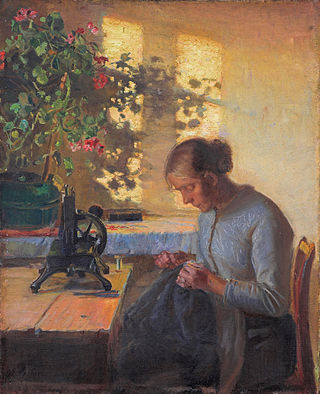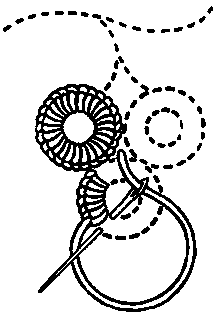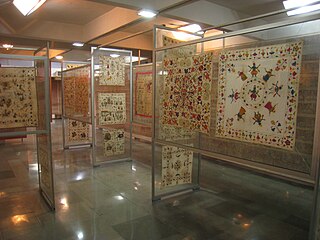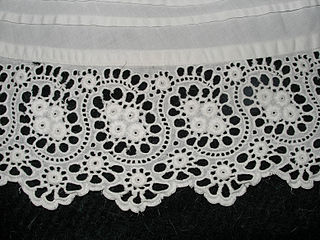
Embroidery is the craft of decorating fabric or other materials using a needle to apply thread or yarn. Embroidery may also incorporate other materials such as pearls, beads, quills, and sequins. In modern days, embroidery is usually seen on caps, hats, coats, overlays, blankets, dress shirts, denim, dresses, stockings, scarfs, and golf shirts. Embroidery is available in a wide variety of thread or yarn colour. It is often used to personalize gifts or clothing items.

A needlework sampler is a piece of embroidery or cross-stitching produced as a 'specimen of achievement', demonstration or a test of skill in needlework. It often includes the alphabet, figures, motifs, decorative borders and sometimes the name of the person who embroidered it and the date. The word sampler is derived from the Latin exemplum, which means 'example'.

Assisi embroidery is a form of counted-thread embroidery based on an ancient Italian needlework tradition in which the background is filled with embroidery stitches and the main motifs are outlined but not stitched. The name is derived from the Italian town of Assisi where the modern form of the craft originated.

Hardanger embroidery or "Hardangersøm" is a form of embroidery traditionally worked with white thread on white even-weave linen or cloth, using counted thread and drawn thread work techniques. It is sometimes called whitework embroidery.

Drawn thread work is one of the earliest forms of open work embroidery, and has been worked throughout Europe. Originally it was often used for ecclesiastical items and to ornament shrouds. It is a form of counted-thread embroidery based on removing threads from the warp and/or the weft of a piece of even-weave fabric. The remaining threads are grouped or bundled together into a variety of patterns. The more elaborate styles of drawn thread work use a variety of other stitches and techniques, but the drawn thread parts are their most distinctive element. It is also grouped with whitework embroidery because it was traditionally done in white thread on white fabric and is often combined with other whitework techniques.

Sashiko is a type of traditional Japanese embroidery or stitching used for the decorative and/or functional reinforcement of cloth and clothing. Owing to the relatively cheap nature of white cotton thread and the abundant nature of cheap, indigo-dyed blue cloth in historical Japan, sashiko has a distinctive appearance of white-on-blue embroidery, though some decorative pieces may also use red thread.

Sewing is the craft of fastening or attaching objects using stitches made with a sewing needle and thread. Sewing is one of the oldest of the textile arts, arising in the Paleolithic era. Before the invention of spinning yarn or weaving fabric, archaeologists believe Stone Age people across Europe and Asia sewed fur and leather clothing using bone, antler or ivory sewing-needles and "thread" made of various animal body parts including sinew, catgut, and veins.

Chain stitch is a sewing and embroidery technique in which a series of looped stitches form a chain-like pattern. Chain stitch is an ancient craft – examples of surviving Chinese chain stitch embroidery worked in silk thread have been dated to the Warring States period. Handmade chain stitch embroidery does not require that the needle pass through more than one layer of fabric. For this reason the stitch is an effective surface embellishment near seams on finished fabric. Because chain stitches can form flowing, curved lines, they are used in many surface embroidery styles that mimic "drawing" in thread.

In everyday language, a stitch in the context of embroidery or hand-sewing is defined as the movement of the embroidery needle from the back of the fibre to the front side and back to the back side. The thread stroke on the front side produced by this is also called stitch. In the context of embroidery, an embroidery stitch means one or more stitches that are always executed in the same way, forming a figure. Embroidery stitches are also called stitches for short.

Aida cloth is an open, even-weave fabric traditionally used for cross-stitch embroidery. This cotton fabric has a natural mesh that facilitates cross-stitching and enough natural stiffness that the crafter does not need to use an embroidery hoop.

Darning is a sewing technique for repairing holes or worn areas in fabric or knitting using needle and thread alone. It is often done by hand, but using a sewing machine is also possible. Hand darning employs the darning stitch, a simple running stitch in which the thread is "woven" in rows along the grain of the fabric, with the stitcher reversing direction at the end of each row, and then filling in the framework thus created, as if weaving. Darning is a traditional method for repairing fabric damage or holes that do not run along a seam, and where patching is impractical or would create discomfort for the wearer, such as on the heel of a sock.

Korean embroidery techniques and artifacts have a long history, but there is the most evidence from the Joseon Dynasty, after the 14th century in Korea. This article talks about the history, styles, preservation, artists, and examples of screens, costumes, and domestic wares of this exacting and beautiful art form.

Backstitch or back stitch and its variants stem stitch, outline stitch and split stitch are a class of embroidery and sewing stitches in which individual stitches are made backward to the general direction of sewing. In embroidery, these stitches form lines and are most often used to outline shapes and to add fine detail to an embroidered picture. It is also used to embroider lettering. In hand sewing, it is a utility stitch which strongly and permanently attaches two pieces of fabric. The small stitches done back-and-forth makes the back stitch the strongest stitch among the basic stitches. Hence it can be used to sew strong seams by hand, without a sewing machine.

Embroidery in India includes dozens of embroidery styles that vary by region and clothing styles. Designs in Indian embroidery are formed on the basis of the texture and the design of the fabric and the stitch. The dot and the alternate dot, the circle, the square, the triangle, and permutations and combinations of these constitute the design.
The manufacture of textiles is one of the oldest of human technologies. To make textiles, the first requirement is a source of fiber from which a yarn can be made, primarily by spinning. The yarn is processed by knitting or weaving, which turns yarn into cloth. The machine used for weaving is the loom. For decoration, the process of colouring yarn or the finished material is dyeing. For more information of the various steps, see textile manufacturing.

Cutwork or cut work, also known as punto tagliato in Italian, is a needlework technique in which portions of a textile, typically cotton or linen, are cut away and the resulting "hole" is reinforced and filled with embroidery or needle lace.

An embroidered patch, also known as a cloth badge, is a piece of embroidery which is created by using a fabric backing and thread. The art of making embroidered patches is an old tradition and was done by hand. During the first half of the twentieth century they were commonly embroidered using a shiffli embroidery machine. High-speed, computerized machines have led to mass production.
Sewing is the craft of fastening or attaching objects using stitches made with needle and thread. Sewing is one of the oldest of the textile arts, arising in the Paleolithic Era. Although usually associated with clothing and household linens, sewing is used in a variety of crafts and industries, including shoemaking, upholstery, sailmaking, bookbinding and the manufacturing of some kinds of sporting goods. Sewing is the fundamental process underlying a variety of textile arts and crafts, including embroidery, tapestry, quilting, appliqué and patchwork.

The Kutch Embroidery is a handicraft and textile signature art tradition of the tribal community of Kutch District in Gujarat, India. This embroidery with its rich designs has made a notable contribution to the Indian embroidery traditions. The embroidery, practiced normally by women is generally done on fabrics of cotton, in the form of a net using cotton or silk threads. In certain patterns, it is also crafted over silk and satin. The types of stitches adopted are “square chain, double buttonhole, pattern darning, running stitch, satin and straight stitches”. The signature effect of the colorful embroidery sparkles when small mirrors called abhla are sewn over the geometrically shaped designs. Depending on the tribal sub groups of Rabari, Garasia Jat, and Mutava involved with this craft work many hand embroidered ethnic styles have evolved. These six styles: Suf, khaarek, paako, Rabari, Garasia Jat, and Mutava.

The term Hedebo embroidery covers several forms of white embroidery which originated in the Hedebo (heathland) region of Zealand, Denmark, in the 1760s. The varied techniques which evolved over the next hundred years in the farming community were subsequently developed by the middle classes until around 1820. They were applied to articles of clothing such as collars and cuffs but were also used to decorate bed linen.




























